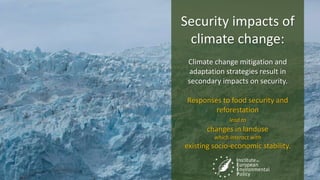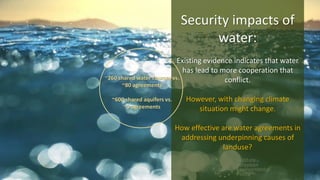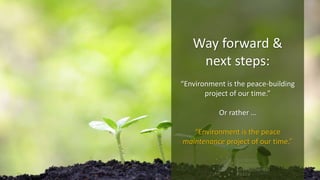Exploring the environment and security nexus
- 1. www.ieep.eu @IEEP_eu Environment and Security - Key aspects and considerations - Based on key insights from “Peace and Security in the 21st Century: Understanding the Environment-Security Nexus” training by UNEP and ICPS, 6 – 10 Nov 2017 / London Marianne Kettunen Principal Policy Analyst / Head of Global Challenges and SDGs @ IEEP .
- 2. How to define environment & security nexus? No-one knows, yet. Conflict vs. broader security National security vs. individual security
- 3. Environment in a conflict situation: Environment & natural resources play different roles at different stages: prevention – conflict – peace-building – future recovery. Since 1990s, at least 18 conflicts (partly) attributed to natural resources. Prevention a key focal point of the future regime?
- 4. Environment in migration: Role still unclear, with limited empirical evidence. Environmental migration vs. political or economic migration. Based on existing evidence, env. migrants stay within a country with a desire to return. But what if they cannot?
- 5. Environment & international security: Varying success in featuring environment (climate change and water) at the UN Security Council. Water has a more permanent status than climate change. Integration of climate change could alter geopolitical “who-is-who” status quo → resistance.
- 6. Security impacts of climate change: Complex web between environmental changes, socio-economic and political instability, empirical evidence both contradicting and limited. “Climate change results in conflict” is too simplistic and even inaccurate statement. Conflict needs also economic interruptions, marginalised groups and weak institutions.
- 7. Security impacts of climate change: Climate change mitigation and adaptation strategies result in secondary impacts on security. Responses to food security and reforestation lead to changes in landuse which interact with existing socio-economic stability.
- 8. Security impacts of agricultural resources: Changes in resource availability and interruptions to the sector have played a role in past conflicts. Climate change – agricultural sector – marginalised groups – ineffective institutions.
- 9. Security impacts of water: Existing evidence indicates that water has lead to more cooperation that conflict. However, with changing climate situation might change. How effective are water agreements in addressing underpinning causes of landuse? ~260 shared water courses vs. ~80 agreements ~600 shared aquifers vs. ~5 agreements
- 10. Security impacts of fisheries resources: The fate of small scale fisheries might not have major direct impacts on national economy or security, but the domino effects might. Depletion of fisheries resources in the coast of Somalia one key underlying factor for increased piracy.
- 11. Role of natural hazards & disasters: Natural hazard is the starting point, natural disaster is the aftermath. Latter is largely determined by ability to respond (e.g. societal, economic and environmental factors). Well-functioning ecosystem play a role in both prevention and recovery.
- 12. Role of private sector: While it is desirable for private sector to play a role, it is unclear to what extent and what are the risks. Insurance and investment sectors?
- 13. Way forward & next steps: A successful regime for environment and security requires action at all levels. Gathering and synthesis of evidence (Stern and TEEB report style) seen as a key next step. International Varying motivations for building an international regime. How to make relevant from Belgium to Bangladesh? National Key challenge is making environment relevant to (immediate) national security agenda. Regional Existing regional frameworks for water could be used for awareness and action. Local Concrete actions happen at local level. How to “reach out” to this level from an international framework?
- 14. Way forward & next steps: “Environment is the peace-building project of our time.” Or rather … “Environment is the peace maintenance project of our time.”
Editor's Notes
- IEEP’s @tenBrinkPatrick discusses #GreenJobs at #EUGreenWeek.
- IEEP’s @tenBrinkPatrick discusses #GreenJobs at #EUGreenWeek.
- IEEP’s @tenBrinkPatrick discusses #GreenJobs at #EUGreenWeek.
- IEEP’s @tenBrinkPatrick discusses #GreenJobs at #EUGreenWeek.
- IEEP’s @tenBrinkPatrick discusses #GreenJobs at #EUGreenWeek.
- IEEP’s @tenBrinkPatrick discusses #GreenJobs at #EUGreenWeek.
- IEEP’s @tenBrinkPatrick discusses #GreenJobs at #EUGreenWeek.
- IEEP’s @tenBrinkPatrick discusses #GreenJobs at #EUGreenWeek.
- IEEP’s @tenBrinkPatrick discusses #GreenJobs at #EUGreenWeek.
- IEEP’s @tenBrinkPatrick discusses #GreenJobs at #EUGreenWeek.
- IEEP’s @tenBrinkPatrick discusses #GreenJobs at #EUGreenWeek.
- IEEP’s @tenBrinkPatrick discusses #GreenJobs at #EUGreenWeek.
- IEEP’s @tenBrinkPatrick discusses #GreenJobs at #EUGreenWeek.














